
Am Fam Physician. 2014;89(2):106-113
Patient information: See related handout on tinnitus, written by the author of this article.
Author disclosure: No relevant financial affiliations.
Tinnitus, a common symptom encountered in family medicine, is defined as the perception of noise in the absence of an acoustic stimulus outside of the body. Because tinnitus is a symptom and not a disease, its underlying cause must be determined to best help patients. Although tinnitus is often idiopathic, sensorineural hearing loss is the most common identified cause. It can also be caused by other otologic, vascular, neoplastic, neurologic, pharmacologic, dental, and psychological factors. More serious causes, such as Meniere disease or vestibular schwannoma, can be excluded during the evaluation. History and physical examination of the head, eyes, ears, nose, throat, neck, and neurologic system guide subsequent evaluation. Almost all patients with tinnitus should undergo audiometry with tympanometry, and some patients require neuroimaging or assessment of vestibular function with electronystagmography. Supportive counseling should begin during the initial evaluation to help patients cope with tinnitus. Counseling may also improve the chances of successful subsequent treatment.
Tinnitus is a common symptom encountered in family medicine. It is defined as sound perception in the absence of sound input external to the patient. Subjective tinnitus is the most common type, and is audible only to the patient, without internal or external sound input. Objective tinnitus is rare, accounting for less than 1% of cases.1 It involves the perception of an internal sound, such as a bruit, as tinnitus. The causes of objective tinnitus are chiefly vascular or muscle dysfunction.2
Tinnitus lasting at least five minutes was reported by 30% of persons 49 years and older in an Australian population-based cohort.3 In a U.S. population-based study, slightly more than 8% of persons 48 years and older were affected by tinnitus that was moderately severe or that impacted sleep.4 Although it can be transient, older persons are more likely to have persistent tinnitus.5 A simple and efficient approach to the evaluation and diagnosis of tinnitus can safely detect the minority of persons with more serious etiologies, such as Meniere disease or vestibular schwannoma.
| Clinical recommendation | Evidence rating | References |
|---|---|---|
| Patients with chronic tinnitus should undergo pure tone audiometry. | C | 34, 49 |
| Patients with unilateral tinnitus or asymmetric sensorineural hearing loss should undergo neuroimaging. | C | 33 |
| Non–contrast-enhanced T2- and T2*-weighted MRI may be equivalent to contrast-enhanced MRI for the evaluation of vestibular schwannoma. | C | 33 |
| Patients with pulsatile tinnitus should be evaluated with neurovascular imaging. The choice of imaging technique depends on whether arterial or venous tinnitus is suspected. | C | 51, 55 |
Etiology
Because tinnitus is a symptom and not a disease, there is no objective test to confirm its existence or grade its severity.6 For this reason, much of the workup for tinnitus is without evidence. The etiology of tinnitus is often multifactorial, but in many cases, it is a response of the central nervous system to insufficient or abnormal input from the ear, comparable to phantom limb syndrome.7 In this syndrome, persons perceive their limb even after it has been amputated. In a similar manner, tinnitus persists even after surgical transection of the auditory nerve.7
Tinnitus occurs in most persons with normal hearing who are exposed to silence.8 It can be affected by input outside of the auditory system. For example, in patients with somatosensory tinnitus, movements of the head, neck, or limbs or palpation of myofascial trigger points can modulate or reproduce tinnitus.9 The belief that tinnitus is entirely psychosomatic is outmoded. Appreciation of a person's subjective response to tinnitus can help establish a therapeutic alliance that will support further education and therapy.
Table 1 lists the common etiologies of tinnitus.1,2,10–15 The condition most often associated with tinnitus is sensorineural hearing loss caused by presbycusis or occupational noise exposure.3,16 Conductive hearing loss from cerumen impaction, middle ear effusion, or otosclerosis is also associated with tinnitus.4 Although certain metabolic conditions were previously thought to cause tinnitus, there is little evidence to support this.15 A Medline search found no studies linking tinnitus with thyroid disease. The search found a single case report and a weakly suggestive observational study linking tinnitus with vitamin B12 deficiency,17,18 as well as several case series and small observational studies inconsistently suggesting a link between tinnitus and hyperlipidemia or diabetes mellitus.19–24
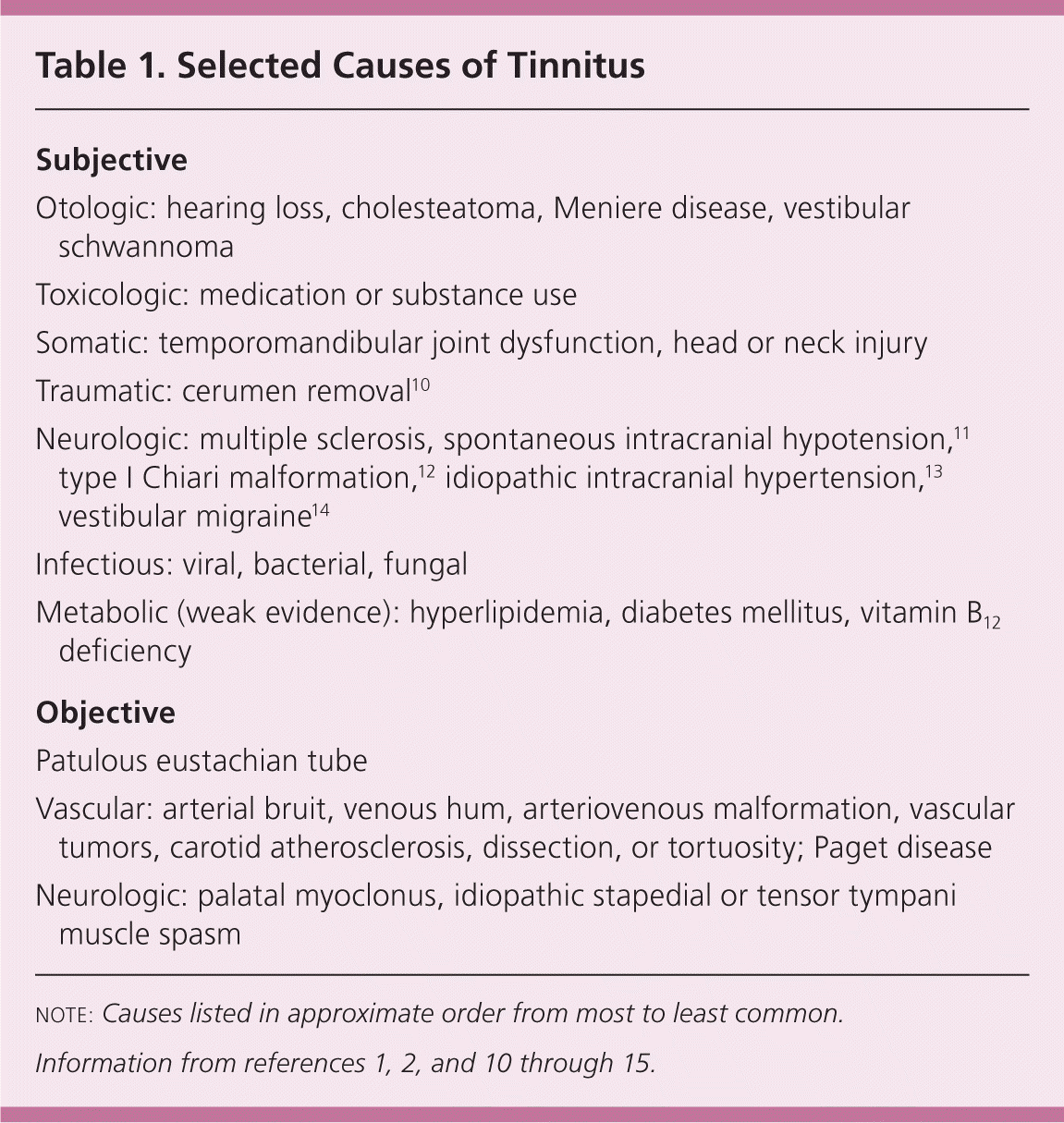
| Subjective |
| Otologic: hearing loss, cholesteatoma, Meniere disease, vestibular schwannoma |
| Toxicologic: medication or substance use |
| Somatic: temporomandibular joint dysfunction, head or neck injury |
| Traumatic: cerumen removal10 |
| Neurologic: multiple sclerosis, spontaneous intracranial hypotension,11 type I Chiari malformation,12 idiopathic intracranial hypertension,13 vestibular migraine14 |
| Infectious: viral, bacterial, fungal |
| Metabolic (weak evidence): hyperlipidemia, diabetes mellitus, vitamin B12 deficiency |
| Objective |
| Patulous eustachian tube |
| Vascular: arterial bruit, venous hum, arteriovenous malformation, vascular tumors, carotid atherosclerosis, dissection, or tortuosity; Paget disease |
| Neurologic: palatal myoclonus, idiopathic stapedial or tensor tympani muscle spasm |
More than 130 medications have been reported to cause tinnitus or hearing loss.25 To decrease the risk of iatrogenic tinnitus, patients should avoid using more than one potentially ototoxic agent concurrently, and should limit the dose and duration, especially if other risk factors for tinnitus are present. Table 2 lists common medications consistently associated with tinnitus.25,26
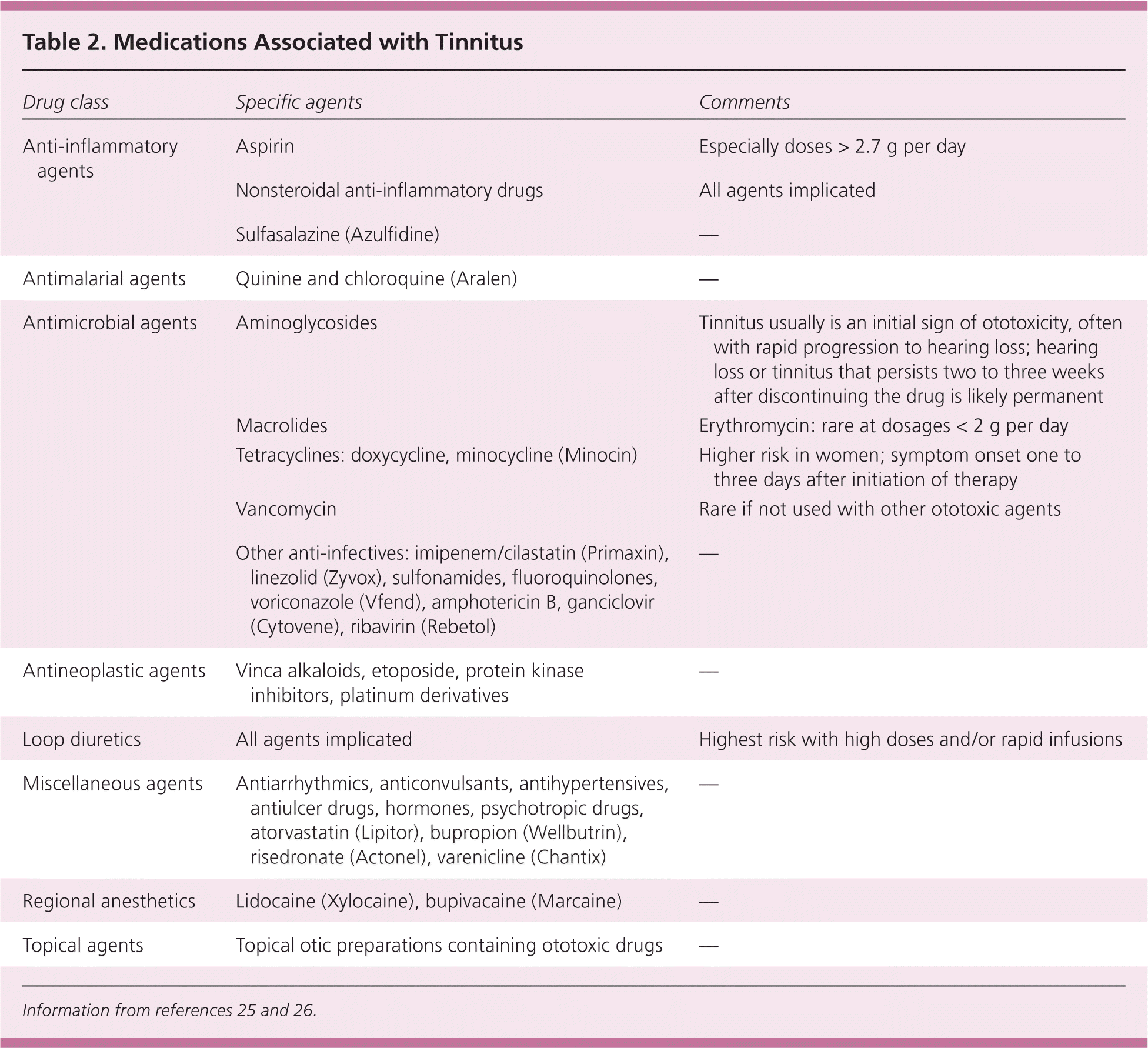
| Drug class | Specific agents | Comments |
|---|---|---|
| Anti-inflammatory agents | Aspirin | Especially doses > 2.7 g per day |
| Nonsteroidal anti-inflammatory drugs | All agents implicated | |
| Sulfasalazine (Azulfidine) | — | |
| Antimalarial agents | Quinine and chloroquine (Aralen) | — |
| Antimicrobial agents | Aminoglycosides | Tinnitus usually is an initial sign of ototoxicity, often with rapid progression to hearing loss; hearing loss or tinnitus that persists two to three weeks after discontinuing the drug is likely permanent |
| Macrolides | Erythromycin: rare at dosages < 2 g per day | |
| Tetracyclines: doxycycline, minocycline (Minocin) | Higher risk in women; symptom onset one to three days after initiation of therapy | |
| Vancomycin | Rare if not used with other ototoxic agents | |
| Other anti-infectives: imipenem/cilastatin (Primaxin), linezolid (Zyvox), sulfonamides, fluoroquinolones, voriconazole (Vfend), amphotericin B, ganciclovir (Cytovene), ribavirin (Rebetol) | — | |
| Antineoplastic agents | Vinca alkaloids, etoposide, protein kinase inhibitors, platinum derivatives | — |
| Loop diuretics | All agents implicated | Highest risk with high doses and/or rapid infusions |
| Miscellaneous agents | Antiarrhythmics, anticonvulsants, antihypertensives, antiulcer drugs, hormones, psychotropic drugs, atorvastatin (Lipitor), bupropion (Wellbutrin), risedronate (Actonel), varenicline (Chantix) | — |
| Regional anesthetics | Lidocaine (Xylocaine), bupivacaine (Marcaine) | — |
| Topical agents | Topical otic preparations containing ototoxic drugs | — |
Some studies suggest that a somatosensory component may be present in some patients with tinnitus, although this is not fully understood. Tinnitus may be associated with temporomandibular joint dysfunction27 and whiplash,3 and may be modulated by body movements.28 Several neurologic conditions can produce tinnitus. For example, spontaneous intracranial hypotension is an uncommon but increasingly recognized cause of daily or thunderclap headache; it results from a spontaneous cerebrospinal fluid leak often following a forceful Valsalva maneuver.11 Spontaneous intracranial hypotension is characterized by a positional headache similar to a post–dural puncture headache, and patients may have associated tinnitus. Idiopathic intracranial hypertension is another neurologic cause of tinnitus that occurs primarily in women who are overweight.13 Vestibular migraine is characterized by vertiginous symptoms coincident at least twice with migraine symptoms in persons with a history of recurrent vestibular symptoms and migraine.14
Meniere disease is characterized by intermittent episodes of vertigo, fluctuating hearing loss, tinnitus, and ear pressure secondary to malabsorption of endolymphatic fluid in the inner ear.29 Patients may present with any one of these symptoms or a combination of symptoms, making early diagnosis a challenge.30 Meniere disease has an annual incidence of 4.3 per 100,000 persons, a prevalence of 17 to 46 per 100,000 persons, and a peak age of onset of 40 to 60 years.29 Diagnosis depends on the presence of typical symptoms, with or without audiometrically documented hearing loss.31 When hearing loss is documented in patients with Meniere disease, it is usually noted in lower pitches.30
Vestibular schwannoma, formerly known as acoustic neuroma, is a benign tumor of the acoustic nerve presenting most commonly as progressive unilateral or asymmetric hearing loss, with or without tinnitus, vertigo, or both.32–34 It is rare for tinnitus to be the only symptom.35 Only 1% to 2% of patients presenting with the classic symptoms of unilateral hearing loss with or without unilateral tinnitus have a schwannoma.36 The incidence is about one per 100,000 persons in the United States,37 although it has been increasing over the past several decades, in part because of better detection.38 Although some investigators have speculated that cellular telephone use has contributed to this apparent increase,39 studies do not show a consistent association.
Tinnitus is associated with increased prevalence of depression and anxiety; however, the precise timing and sequence of the relationship is unclear.40,41 There is no evidence that affective disorders cause tinnitus, but anxiety or depression may alter a patient's toleration of tinnitus or be exacerbated by tinnitus.40,41 Individual personality factors, such as being more socially withdrawn, less tolerant of stress, and more likely to feel victimized by life's circumstances, were associated with longer duration of and greater annoyance from tinnitus in a New Zealand cohort.42
Clinical Diagnosis
HISTORY AND PHYSICAL EXAMINATION
History and physical examination are the primary diagnostic tools for tinnitus. Table 3 lists historical items that are helpful in the evaluation of a patient with tinnitus.2–4,6,11,13,16,25,27,30–32,43–49 Key elements of the physical examination include the head, eyes, ears, nose, throat, neck, and neurologic system. Table 4 provides physical examination findings that are helpful in the evaluation of a patient with tinnitus.2,3,10,11,32,35,45,50,51
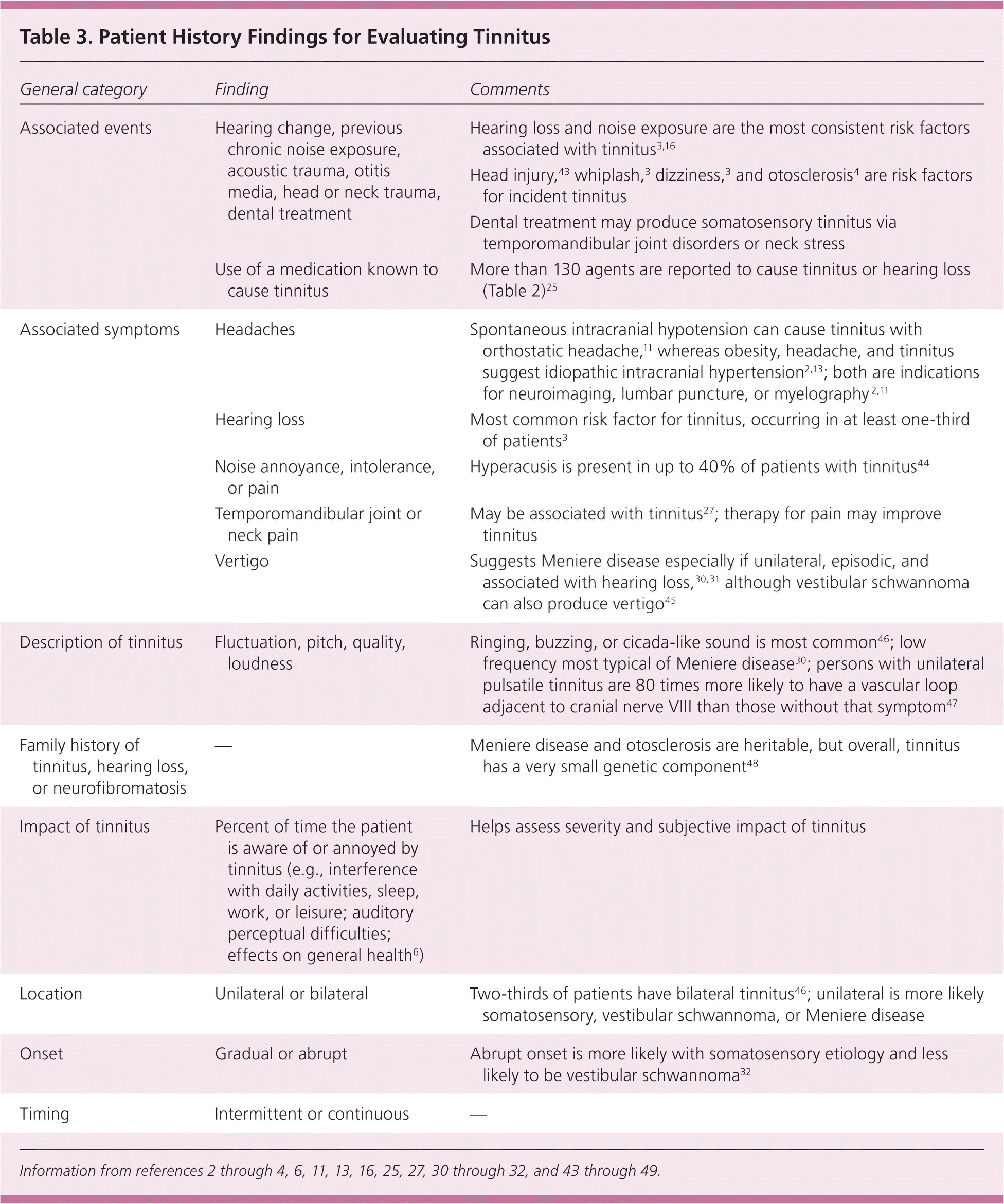
| General category | Finding | Comments |
|---|---|---|
| Associated events | Hearing change, previous chronic noise exposure, acoustic trauma, otitis media, head or neck trauma, dental treatment | Hearing loss and noise exposure are the most consistent risk factors associated with tinnitus3,16 |
| Head injury,43 whiplash,3 dizziness,3 and otosclerosis4 are risk factors for incident tinnitus | ||
| Dental treatment may produce somatosensory tinnitus via temporomandibular joint disorders or neck stress | ||
| Use of a medication known to cause tinnitus | More than 130 agents are reported to cause tinnitus or hearing loss (Table 2)25 | |
| Associated symptoms | Headaches | Spontaneous intracranial hypotension can cause tinnitus with orthostatic headache,11 whereas obesity, headache, and tinnitus suggest idiopathic intracranial hypertension2,13; both are indications for neuroimaging, lumbar puncture, or myelography 2,11 |
| Hearing loss | Most common risk factor for tinnitus, occurring in at least one-third of patients3 | |
| Noise annoyance, intolerance, or pain | Hyperacusis is present in up to 40% of patients with tinnitus44 | |
| Temporomandibular joint or neck pain | May be associated with tinnitus27; therapy for pain may improve tinnitus | |
| Vertigo | Suggests Meniere disease especially if unilateral, episodic, and associated with hearing loss,30,31 although vestibular schwannoma can also produce vertigo45 | |
| Description of tinnitus | Fluctuation, pitch, quality, loudness | Ringing, buzzing, or cicada-like sound is most common46; low frequency most typical of Meniere disease30; persons with unilateral pulsatile tinnitus are 80 times more likely to have a vascular loop adjacent to cranial nerve VIII than those without that symptom47 |
| Family history of tinnitus, hearing loss, or neurofibromatosis | — | Meniere disease and otosclerosis are heritable, but overall, tinnitus has a very small genetic component48 |
| Impact of tinnitus | Percent of time the patient is aware of or annoyed by tinnitus (e.g., interference with daily activities, sleep, work, or leisure; auditory perceptual difficulties; effects on general health6) | Helps assess severity and subjective impact of tinnitus |
| Location | Unilateral or bilateral | Two-thirds of patients have bilateral tinnitus46; unilateral is more likely somatosensory, vestibular schwannoma, or Meniere disease |
| Onset | Gradual or abrupt | Abrupt onset is more likely with somatosensory etiology and less likely to be vestibular schwannoma32 |
| Timing | Intermittent or continuous | — |
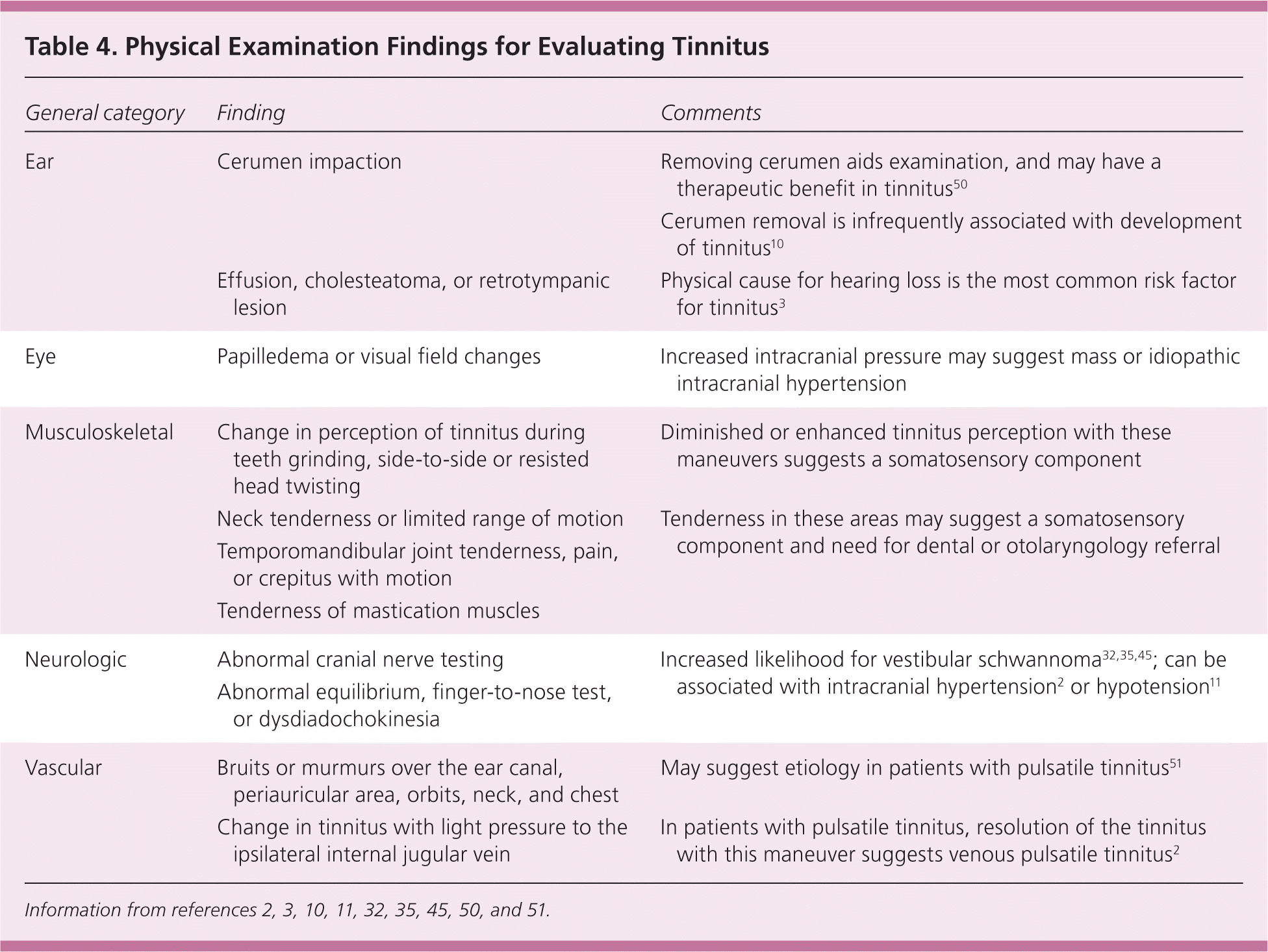
| General category | Finding | Comments |
|---|---|---|
| Ear | Cerumen impaction | Removing cerumen aids examination, and may have a therapeutic benefit in tinnitus50 |
| Cerumen removal is infrequently associated with development of tinnitus10 | ||
| Effusion, cholesteatoma, or retrotympanic lesion | Physical cause for hearing loss is the most common risk factor for tinnitus3 | |
| Eye | Papilledema or visual field changes | Increased intracranial pressure may suggest mass or idiopathic intracranial hypertension |
| Musculoskeletal | Change in perception of tinnitus during teeth grinding, side-to-side or resisted head twisting | Diminished or enhanced tinnitus perception with these maneuvers suggests a somatosensory component |
| Neck tenderness or limited range of motion | Tenderness in these areas may suggest a somatosensory component and need for dental or otolaryngology referral | |
| Temporomandibular joint tenderness, pain, or crepitus with motion | ||
| Tenderness of mastication muscles | ||
| Neurologic | Abnormal cranial nerve testing | Increased likelihood for vestibular schwannoma32,35,45; can be associated with intracranial hypertension2 or hypotension11 |
| Abnormal equilibrium, finger-to-nose test, or dysdiadochokinesia | ||
| Vascular | Bruits or murmurs over the ear canal, periauricular area, orbits, neck, and chest | May suggest etiology in patients with pulsatile tinnitus51 |
| Change in tinnitus with light pressure to the ipsilateral internal jugular vein | In patients with pulsatile tinnitus, resolution of the tinnitus with this maneuver suggests venous pulsatile tinnitus2 |
ANCILLARY STUDIES, IMAGING, AND DIAGNOSTIC TESTS
Figure 1 is a suggested evaluation algorithm based on tinnitus chronicity, accompanying features, and examination findings. Almost all patients presenting with persistent tinnitus should undergo pure tone audiometry with assessment of air and bone conduction, speech discrimination testing, and tympanometry.34,49 Table 5 provides sensitivity and specificity data for several ancillary and imaging studies in the evaluation of patients with tinnitus.29,33,36,52,53 The optimal definition for asymmetric hearing loss has not been studied by randomized controlled trials linked to long-term patient outcomes. A recent cross-sectional study of all published definitions of asymmetric hearing loss found an average difference of 10 dB or greater over 1 to 8 kHz had the best sensitivity for vestibular schwannoma. An average difference of 15 dB or greater over 0.5 to 3 kHz maximized specificity.36
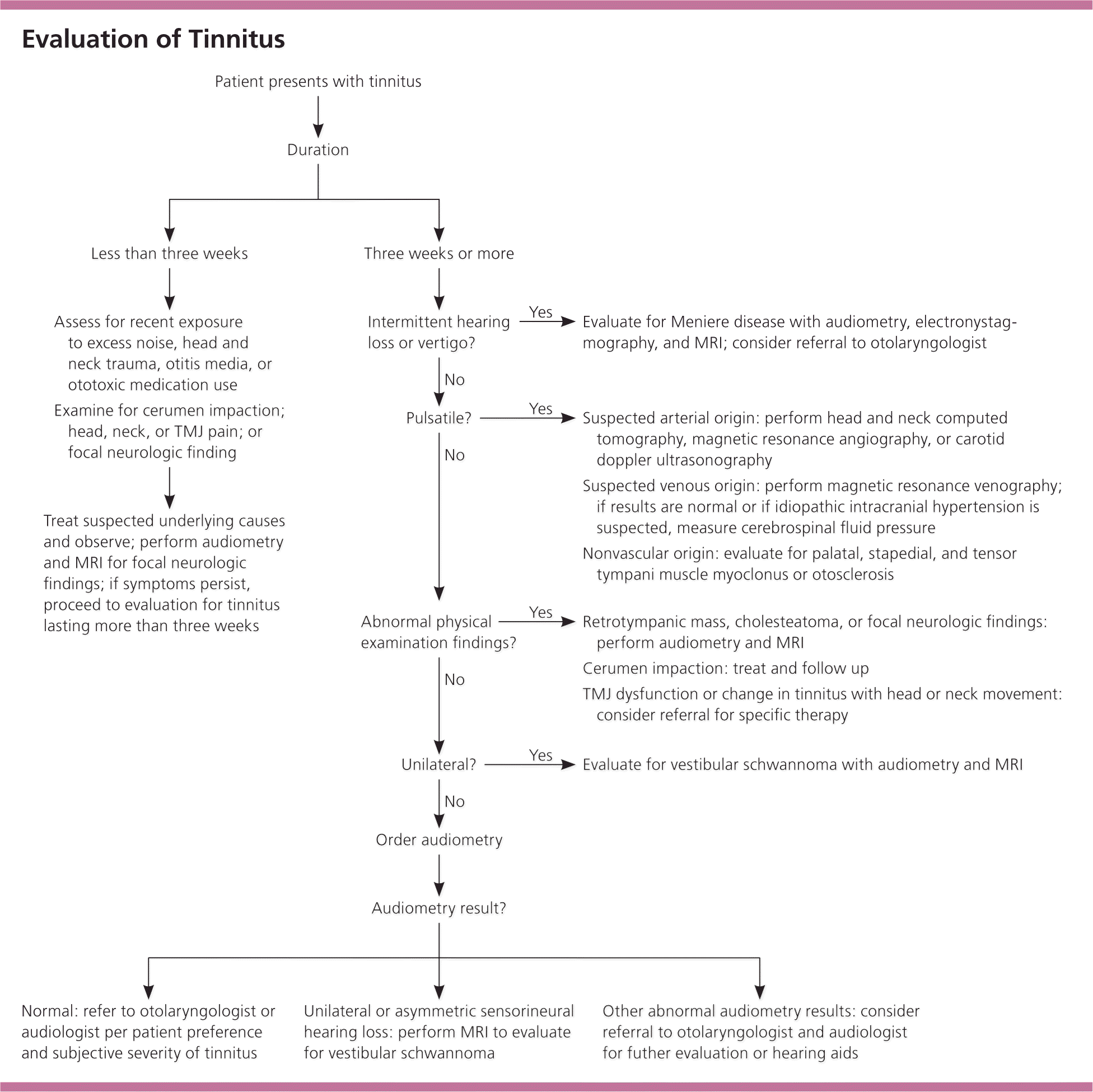
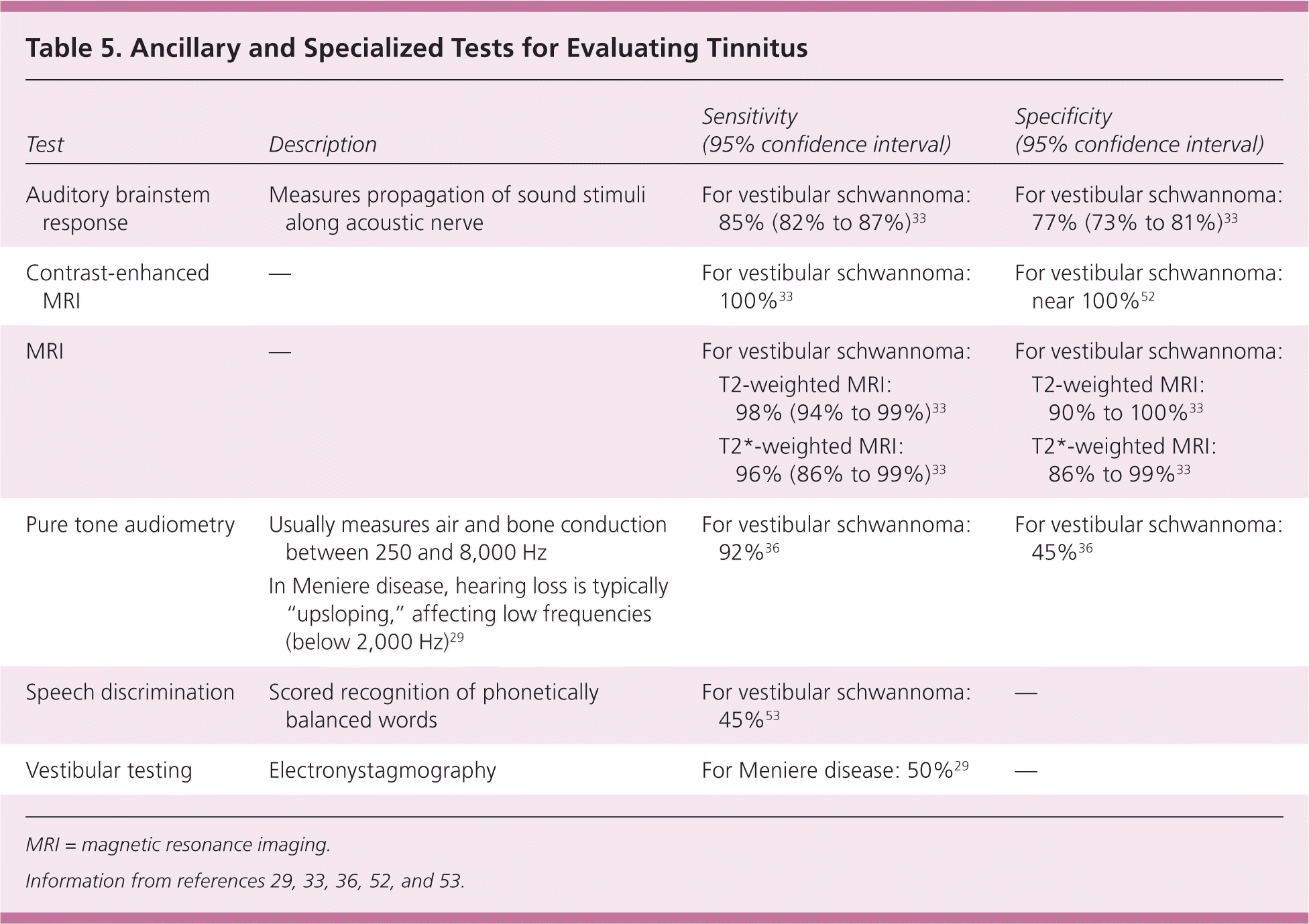
| Test | Description | Sensitivity (95% confidence interval) | Specificity (95% confidence interval) | ||
|---|---|---|---|---|---|
| Auditory brainstem response | Measures propagation of sound stimuli along acoustic nerve | For vestibular schwannoma: 85% (82% to 87%)33 | For vestibular schwannoma: 77% (73% to 81%)33 | ||
| Contrast-enhanced MRI | — | For vestibular schwannoma: 100%33 | For vestibular schwannoma: near 100%52 | ||
| MRI | — | For vestibular schwannoma: | For vestibular schwannoma: | ||
| T2-weighted MRI: 98% (94% to 99%)33 | T2-weighted MRI: 90% to 100%33 | ||||
| T2*-weighted MRI: 96% (86% to 99%)33 | T2*-weighted MRI: 86% to 99%33 | ||||
| Pure tone audiometry | Usually measures air and bone conduction between 250 and 8,000 Hz | For vestibular schwannoma: 92%36 | For vestibular schwannoma: 45%36 | ||
| In Meniere disease, hearing loss is typically “upsloping,” affecting low frequencies (below 2,000 Hz)29 | |||||
| Speech discrimination | Scored recognition of phonetically balanced words | For vestibular schwannoma: 45%53 | — | ||
| Vestibular testing | Electronystagmography | For Meniere disease: 50%29 | — | ||
Previously, the auditory brainstem response (ABR) test has been used to screen for vestibular schwannoma in patients with asymmetric sensorineural hearing loss, unilateral tinnitus or hearing difficulties, symptoms of vestibular dysfunction, or abnormal neurologic examination.35 The ABR test uses a series of clicks to stimulate the ear and then monitors for afferent nerve propagation of the resulting signal.33 However, a systematic review of magnetic resonance imaging (MRI) for the evaluation of suspected vestibular schwannoma concluded that MRI superseded ABR testing.33 Most U.S. otolaryngologists order a contrast-enhanced MRI of the brain and internal auditory canals in the setting of asymmetric hearing loss to rule out vestibular schwannoma. Conversely, a systematic review from the United Kingdom concluded that non–contrast-enhanced T2- and T2*-weighted MRI was the most cost-effective initial examination second to abnormal audiometry because its sensitivity was expected to be comparable with locally available contrast-enhanced MRI studies.33 Similar reviews have not been performed in the United States. In patients unable to undergo MRI, ABR testing or computed tomography is an acceptable alternative.33
For patients with suspected Meniere disease, vestibular testing with electronystagmography, in addition to audiometry and neuroimaging, can help exclude other vestibular disorders. Electronystagmography is a battery of four tests designed to record eye movements in response to visual or vestibular stimuli, thus assessing the peripheral vestibular system. The most common electronystagmography finding in patients with Meniere disease is unilateral vestibular hypofunction.29 No single test confirms a diagnosis of Meniere disease. Rather, the diagnosis is based on a history of fluctuating episodes of tinnitus, hearing loss, aural pressure, vertigo, or a combination of these symptoms.
In patients with pulsatile tinnitus, the choice of imaging test depends on whether arterial or venous tinnitus is suspected. In addition to audiometry, patients with suspected arterial pulsatile tinnitus, retrotympanic lesions, or arterial bruits in the head should be assessed by head and neck computed tomography angiography.51 An arterial bruit confined to the neck can be assessed using carotid Doppler ultrasonography, neck computed tomography angiography, or magnetic resonance angiography.51 Suspected venous pulsatile tinnitus requires MRI, magnetic resonance venography, and, in patients with suspected idiopathic intracranial hypertension, a lumbar puncture and measurement of cerebrospinal fluid pressure.51 In a case series of 145 patients with pulsatile tinnitus, the most common diagnoses were idiopathic intracranial hypertension, atherosclerotic carotid artery disease, and glomus tumors; these diagnoses accounted for two-thirds of all patients in the study.54
Laboratory tests seldom reveal a treatable cause of tinnitus, and little existing evidence supports their use. Laboratory testing should be guided by clinical suspicion rather than the presence of tinnitus because the diagnostic yield is likely to be low. For patients with asymmetric sensorineural hearing loss and tinnitus, syphilis and Lyme serologies are cost-effective ways to identify treatable causes.55
Information for Patients
A population-based study of older patients found that tinnitus persisted in more than 80% of individuals during a follow-up of five years and increased in severity in nearly 50%.5 However, most of the relatively small number of persons with “very annoying” tinnitus at baseline expressed less annoyance at five years, suggesting improved coping over time.5 Because many patients with chronic tinnitus do not have a specific etiology beyond presbycusis,44 supportive counseling can help patients understand the generally benign nature of tinnitus and learn to cope with it. Counseling can also support subsequent therapeutic efforts. In those with intractable and life-altering tinnitus, several otolaryngology and audiology programs offer clinics for learning coping techniques.
Data Sources: A PubMed search was completed in Clinical Queries with the term tinnitus. The search included meta-analyses, randomized controlled trials, clinical trials, and reviews. Essential Evidence was also searched for the terms Meniere disease, tinnitus, and acoustic neuroma. Using the key word tinnitus, a search was performed in Evidence Based Medicine, Bandolier, Cochrane Database of Systematic Reviews, ACP Journal Club, and Database of Abstracts of Reviews of Effectiveness (DARE), Effective Health Care, Institute for Clinical Systems Improvement guidelines, and the National Guideline Clearinghouse. Also searched in PubMed Clinical Queries Diagnosis were the terms acoustic neuroma and Meniere disease. Additionally, a full PubMed search was performed for tinnitus crossed with benign intracranial hypertension, diabetes, thyroid disease, hyperlipidemia, and vitamin B12 deficiency. Search dates: June and July 2010, and July 2013.
